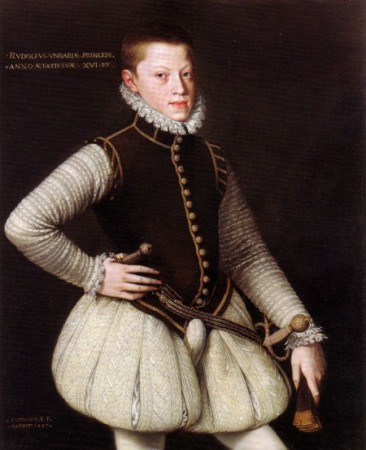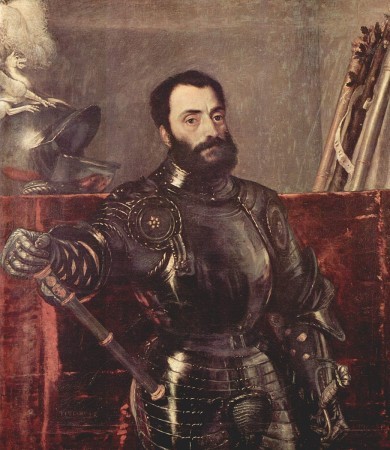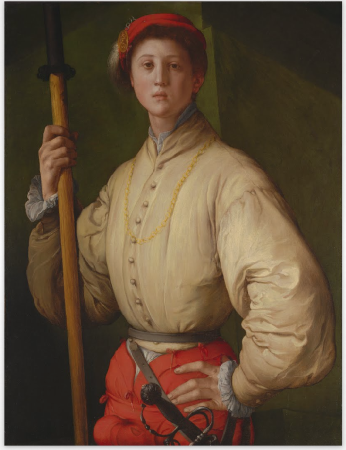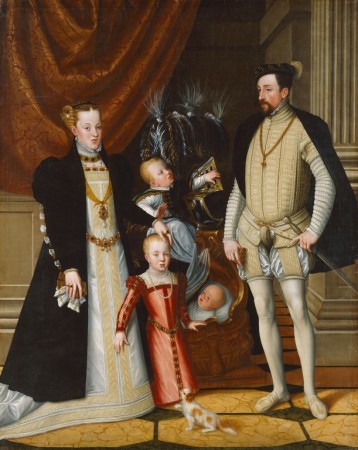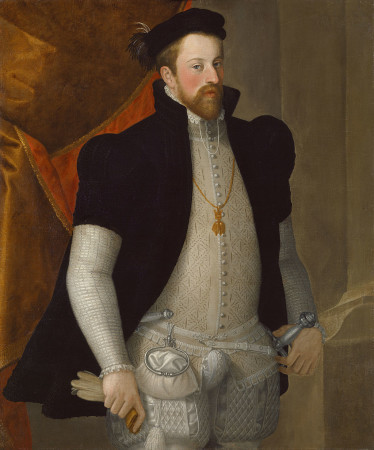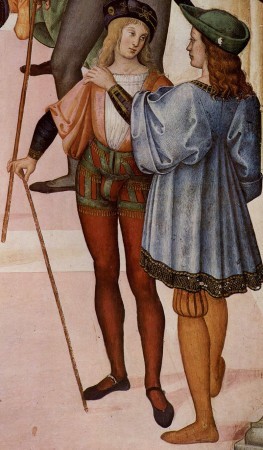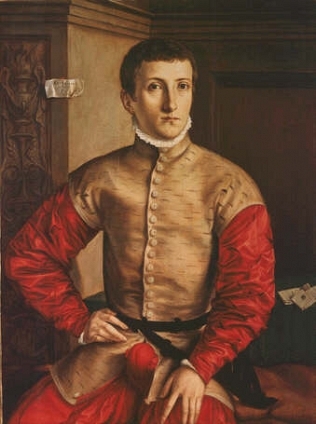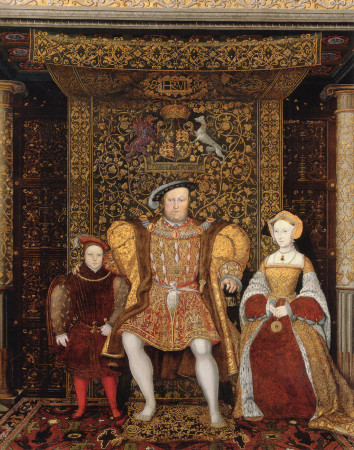Sarah Albee's Blog, page 10
July 10, 2015
Teachers Write!
 I hope you’ll hop over to Kate Messner’s blog today, where I have a guest-author post about writing humor. Here’s the link.
I hope you’ll hop over to Kate Messner’s blog today, where I have a guest-author post about writing humor. Here’s the link.
Teachers/librarians: if you don’t yet know about Teacher’s Write, it’s a free and unique professional development activity for teachers and librarians, organized by Kate, Gae Polisner, and Jo Knowles, with lots of guest authors participating. It’s a wonderful, low-key, supportive and passionate community of writer/educators. It’s not too late to join!
The post Teachers Write! appeared first on Sarah Albee.
July 6, 2015
Curling Up with a Hairdo Archeologist

Flavia statue, which Ms. Stephens describes as a “mullet from hell”
Several Facebook friends* sent me this article from the Wall Street Journal concerning a scholarly journal called the Journal of Roman Archeology, which published an article about ancient Roman hairstyles. You can read the original article here.
It was written by Janet Stephens. She’s not an archeologist. She’s a hairdresser from Baltimore.
I don’t wish to suggest that there’s anything wrong with hairdressers or people from Baltimore publishing articles in scholarly journals. But what’s remarkable is that this piece of original scholarship, published in 2008, is one of only two articles in the journal’s 25-year history written by a non-archeologist.
The premise of her article challenges the general consensus among ancient roman historians that most of these elaborate hairstyles were wigs. Stephens maintains that ancient stylists used women’s real hair, stitching it together with a long, blunt needle and thread in order to build the complex hairstyles. Her theory rests on the translation of the Latin word acus, which can be translated as a single-prong hairpin, a needle and thread, or a curling iron. After poring over ancient texts in translation, she determined that while most historians translated the word as “hairpin,” it was much more likely to have been a large needle, with thread that knitted together braids and affixed larger panels of hair to the head.
She goes on to demonstrate how these Roman hairdos might have been constructed, recreating them on mannequins and real-life hair models. You can see the pictures if you click through to the article.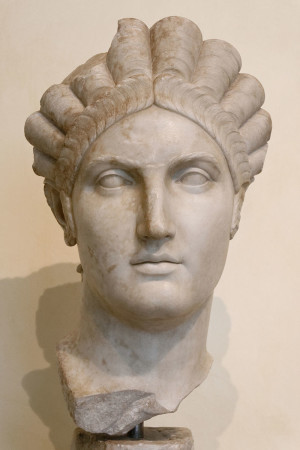
Here’s her video on how to construct a vestal virgin’s hairdo.
(For more about the vestals, you can check out my blog post here.)
*Special thanks to Cathy Ballou Mealey and Dayna Kaufman Lorentz
The post Curling Up with a Hairdo Archeologist appeared first on Sarah Albee.
July 2, 2015
A Grim Reminder
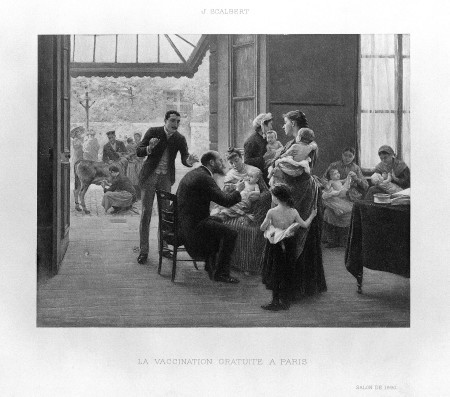 Right now in the headlines there’s a big controversy–in California particularly, but in other states as well–over parents’ right to opt out of having their children vaccinated. As of last week, the California House passed a proposal that would make it illegal for parents to use their family’s personal and religious beliefs as reasons to exempt their children from school vaccinations. Here’s the website for one opt-out movement.
Right now in the headlines there’s a big controversy–in California particularly, but in other states as well–over parents’ right to opt out of having their children vaccinated. As of last week, the California House passed a proposal that would make it illegal for parents to use their family’s personal and religious beliefs as reasons to exempt their children from school vaccinations. Here’s the website for one opt-out movement.
Many of my books touch on the history of infectious diseases, and I’ve lived in parts of the developing world where some of these diseases still occur. So it’s hard to read about parents who have the means to protect their children from so many of these dreaded diseases deciding to opt out of getting them vaccinated.
Let’s turn to Benjamin Franklin for his views on the subject. This is from his autobiography:
“In 1736 I lost one of my sons, a fine boy of four years old, by the smallpox taken in the common way. I long regretted bitterly and still regret that I had not given it to him by inoculation. This I mention for the sake of the parents who omit that operation, on the supposition that they should never forgive themselves if a child died under it; my example showing that the regret may be the same either way, and that, therefore, the safer should be chosen.”
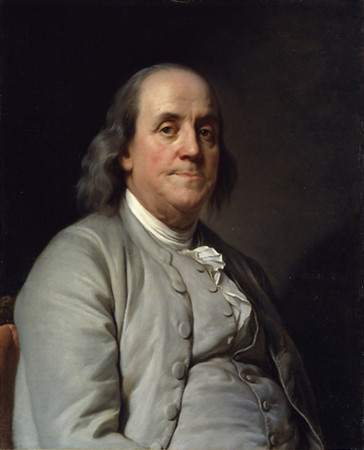 Smallpox outbreaks occurred periodically in Boston where Franklin lived at the time, and if you caught the disease it either killed you or left you immune (and usually scarred). Whenever the disease returned, it struck young children who’d been born since its last visit, and new people who’d arrived. Franklin would have seen at least four big epidemics strike Boston leading up to the birth of his son.
Smallpox outbreaks occurred periodically in Boston where Franklin lived at the time, and if you caught the disease it either killed you or left you immune (and usually scarred). Whenever the disease returned, it struck young children who’d been born since its last visit, and new people who’d arrived. Franklin would have seen at least four big epidemics strike Boston leading up to the birth of his son.
The clergyman and medical man Cotton Mather learned about the use of the smallpox inoculation from his slave, Onsemus, who came from West Africa, and Mather and his college Zabdiel Boylston tried inoculating people during the smallpox epidemic of 1721. It was extremely unpopular, because people feared it would give them the disease rather than prevent it. In fact, about 2% of people died, versus 15% mortality the “common” way. (This was seventy years before Jenner’s discovery of the less-ricky cowpox vaccination, 1798.)
Franklin’s sadness and regret suggest he wishes he’d taken that risk. Parents today, especially those with health insurance and/or the means to protect their kids, should heed his words.
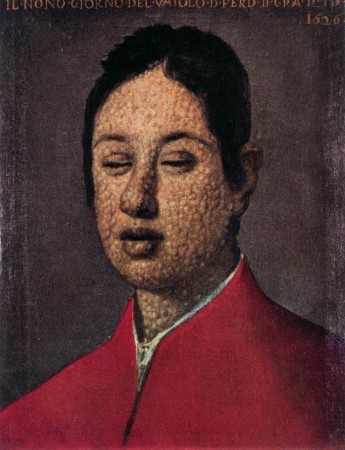
Portrait of Ferdinando de Medici from the sixteenth century
Portrait of Ferdinando II de’ Medici
Date
1626
The post A Grim Reminder appeared first on Sarah Albee.
June 29, 2015
Lead Astray
I’ve been thumbing through old magazines, looking for advertisements to possibly include in my upcoming book, and came across an ad in this issue of The American Magazine, from December, 1923: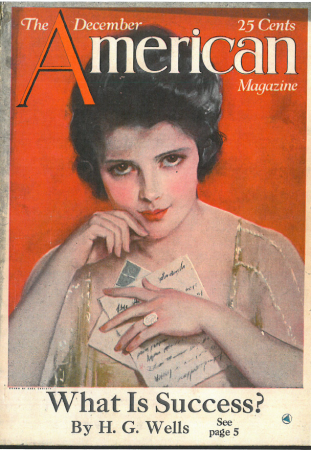 It’s an ad for LEAD PAINT on page 195.
It’s an ad for LEAD PAINT on page 195.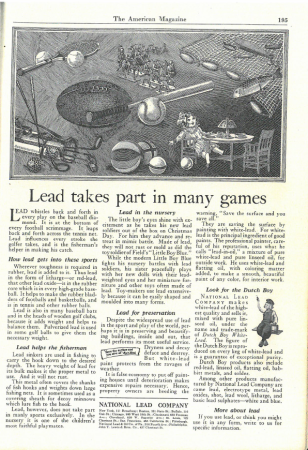 It’s too small and detailed to include in the book, but fascinating nonetheless. A first glance might look like it’s a joke–like this Saturday Night Live spoof where Dan Akroyd and Jane Curtin discuss highly dangerous toys for children.
It’s too small and detailed to include in the book, but fascinating nonetheless. A first glance might look like it’s a joke–like this Saturday Night Live spoof where Dan Akroyd and Jane Curtin discuss highly dangerous toys for children.
But no, it’s not a joke. The National Lead Company proudly touted its products for decades. Shall we look at this in close-up?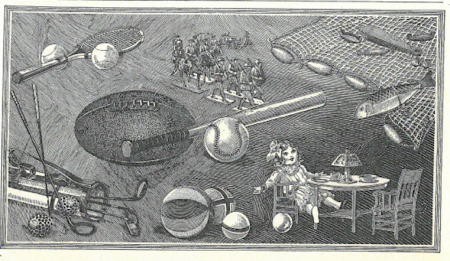 Yes, lead was included in the manufacture of sports equipment for kids, toy soldiers, dolls, fishing tackle, golf clubs, and, of course, paint. This ad was part of the start of a vast marketing and public relations campaign to create a positive image for lead paint. The Little Dutch Boy was the trademark of the company, a golden-haired, flush-cheeked, healthy-looking child with a paintbrush full of lead-based paint in his hand, a reassuring icon for parents, and, like Joe Camel, targeted to appeal to younger consumers.
Yes, lead was included in the manufacture of sports equipment for kids, toy soldiers, dolls, fishing tackle, golf clubs, and, of course, paint. This ad was part of the start of a vast marketing and public relations campaign to create a positive image for lead paint. The Little Dutch Boy was the trademark of the company, a golden-haired, flush-cheeked, healthy-looking child with a paintbrush full of lead-based paint in his hand, a reassuring icon for parents, and, like Joe Camel, targeted to appeal to younger consumers.
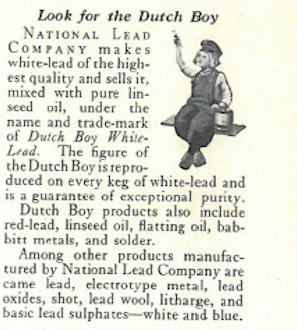 The National Lead Company knew full well that lead was dangerous and toxic, but in the days before strict regulation, they were permitted to advertise to kids and to continue to produce their products with relative impunity. It wasn’t until the 1950s when some brave scientists, notably Clair Patterson, began to publish troubling scientific studies that linked lead exposure to neurological problems in children, at great peril to the scientists’ careers. Public opinion finally began to turn against lead-based paint, and by the 1970s, laws were passed lowering acceptable lead levels in paint.
The National Lead Company knew full well that lead was dangerous and toxic, but in the days before strict regulation, they were permitted to advertise to kids and to continue to produce their products with relative impunity. It wasn’t until the 1950s when some brave scientists, notably Clair Patterson, began to publish troubling scientific studies that linked lead exposure to neurological problems in children, at great peril to the scientists’ careers. Public opinion finally began to turn against lead-based paint, and by the 1970s, laws were passed lowering acceptable lead levels in paint.
Lead manufacturers had more success with lead-based gasoline, which wasn’t phased out completely until 1996.
The post Lead Astray appeared first on Sarah Albee.
June 25, 2015
Mind the Gap
How have I not yet done a blog about codpieces?
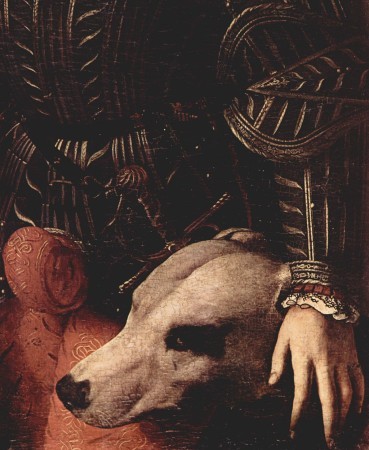 Codpieces are among the more, shall we say, curious fashions of the fifteenth and sixteenth centuries—and that’s saying something, because there were some crazy fashions during this time. They were worn at the crotch area of men’s trousers and held closed with ties or buttons. They were originally conceived as a way to cover up a man’s private parts when the hemlines of men’s tunics became shorter and shorter, until they were barely below the hip. Something had to be done to cover the gap at the top. But even when longer tunics were worn (or balloon breeches came into style), codpieces were worn ornamentally.
Codpieces are among the more, shall we say, curious fashions of the fifteenth and sixteenth centuries—and that’s saying something, because there were some crazy fashions during this time. They were worn at the crotch area of men’s trousers and held closed with ties or buttons. They were originally conceived as a way to cover up a man’s private parts when the hemlines of men’s tunics became shorter and shorter, until they were barely below the hip. Something had to be done to cover the gap at the top. But even when longer tunics were worn (or balloon breeches came into style), codpieces were worn ornamentally.
The post Mind the Gap appeared first on Sarah Albee.
June 22, 2015
A Money Making Endeavor
In honor of the U.S. Treasury’s recent announcement that it plans to put a picture of a woman (gasp) on the ten-dollar bill by the end of this year, I thought I would repost this blog I wrote a couple of years ago, about a cool chapter in the history of American currency.
In 1896, the the Bureau of Engraving and Printing redesigned the U.S. paper money. Four artists were chosen to design the new bills, and the results were pretty spectacular. Instead of showing U.S. Presidents (and Founding Fathers), the new bills were neoclassical allegories.
Sadly, though, when President Cleveland chose not to run again in 1896, his Treasury Secretary retired and was replaced by a new Secretary, Lyman Gage. Gage, a banker by training, held a dim view of the artsy new currency designs, holding that paper bills should be practical, not artistic. Gage cancelled the new currency designs, and it went back to looking more or less the way the modern bills do.
But for almost a year, we had some awesome looking bills. Here’s the one-dollar bill. It shows History (the woman reclining) instructing a student (I’m not sure why he’s nearly naked) and pointing toward an open book showing the US Constitution. And the Washington DC skyline is in the background.
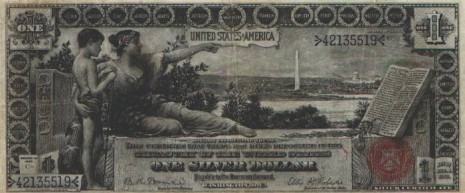 Here’s the back of the one-dollar bill. It shows George and Martha Washington (there’s a refreshing concept!):
Here’s the back of the one-dollar bill. It shows George and Martha Washington (there’s a refreshing concept!):
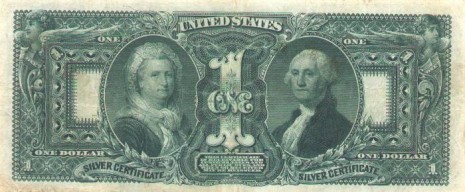 Here’s the two-dollar bill. The central figure is Science, and she is introducing Steam and Electricity (the two kids) to Commerce and Manufacture.
Here’s the two-dollar bill. The central figure is Science, and she is introducing Steam and Electricity (the two kids) to Commerce and Manufacture.
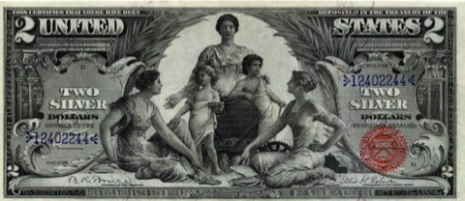 On the back we see Robert Fulton (inventor of the steam engine) and Samuel Morse (inventor of the telegraph).
On the back we see Robert Fulton (inventor of the steam engine) and Samuel Morse (inventor of the telegraph).

And here’s the glorious five-dollar bill. It shows Electricity presenting Light to the World, surrounded by Strength, Fame, and Peace. Although most people loved it, bankers objected to the fact that the numbers on the back of the note weren’t in the corners, making it hard for bank tellers to count money, and religious groups and society ladies objected to Electricity’s nudity and campaigned to recall the bills. So the Treasury promised to move the numbers to the corners, and the artist promised to put more clothing on Electricity for the next printing. (There was no next printing.)

Here’s the back of the fiver, where you see that the numbers aren’t very readable. And yes, those are two Union generals, Ulysses S. Grant and Philip Sheridan, with Liberty between them. This design was probably not so popular in the South.

Sources:
http://flyingmoose.org/truthfic/1896.htm
http://www.philadelphiafed.org/educat...
http://www.frbsf.org/education/teacher-resources/american-currency-exhibit
The post A Money Making Endeavor appeared first on Sarah Albee.
June 18, 2015
Duck, Duck, Geese

A pontic duck
from http://bestiary.ca/beasts/beast259.htm
Fans of Monty Python movies may remember this scene about a killer bunny from the Holy Grail [warning: it’s meant to be funny, but the over-the-top gore may be somewhat upsetting]. What makes it memorable—and comical, in a black-humor kind of way—is that a cute little bunny is such an unlikely antagonist, and yet turns out to be “the most foul, crude, and bad-tempered rodent you ever laid eyes on!”

Vicious
In the real world, cute or unlikely-looking animals have been used for other nefarious or unlikely purposes. King Mithradates of Pontus bred flocks of Pontic ducks, which purportedly preferred to dine on baneful plants like hemlock and belladonna with no ill effects to themselves. And yet their eggs, blood, and meat were poisonous to humans. Mithradates incorporated some of their blood into his famous antidote. At least, that’s what Pliny wrote, although he wasn’t exactly a detail guy.*
And then there are the attack geese. According to Pliny (see above), when the Gauls were about to mount a surprise attack on Rome’s Capitoline Hill in the fourth century BC, the sacred geese who lived in the temple of Juno started honking and flapping their wings like crazy and woke the Roman guards in time to repel the attackers.
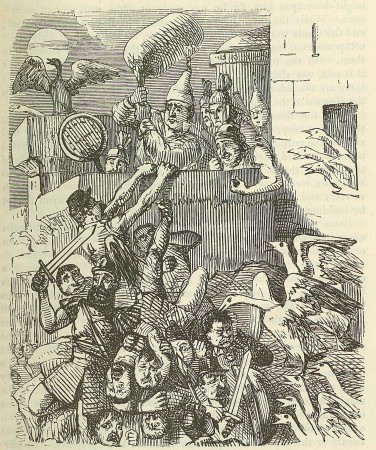 As a result, geese were carried on a litter in a solemn procession every year for the next five centuries.** I’m not really clear why any self-respecting goose would agree to be paraded on a litter and not try to fly away. Pliny is unhelpful on this point.
As a result, geese were carried on a litter in a solemn procession every year for the next five centuries.** I’m not really clear why any self-respecting goose would agree to be paraded on a litter and not try to fly away. Pliny is unhelpful on this point.

Beware of Goose
*Pliny 25.1.1-3 as quoted in Mayor, Poison King p 102 http://www.indiebound.org/book/978069...
**Aelian, On Animals 12.33/Pliny Natural History 29.57 as quoted in McKeown Cabinet of Roman Curiosities, 130. http://www.indiebound.org/book/9780195393750
The post Duck, Duck, Geese appeared first on Sarah Albee.
June 15, 2015
Research Riff
In this book from 1868 called The Guide to General Information on Common Things, written by “A Lady,” I stumbled across this entry called “What is Asbestos?”
I think I’ll let the entry speak for itself.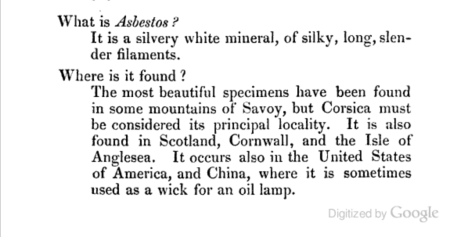
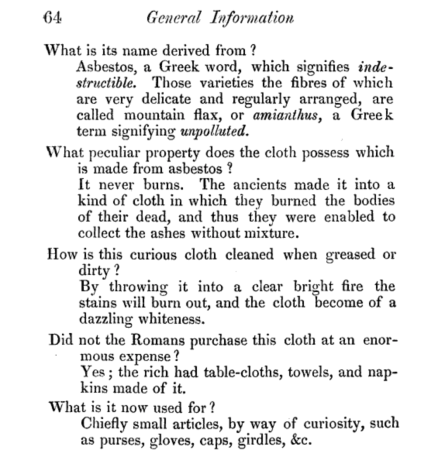
The post Research Riff appeared first on Sarah Albee.
June 11, 2015
Crashing the Party

John Josep Merlin, possibly by Gainsborough
If you think about it, it makes sense that roller skates were invented in Holland. After all, that was the land of ice skating on frozen canals, and putting wheels on your shoes was a great way to ice skate in the summer.

Hendrick Avercamp, Ice Skating Near a Village c 1610 courtesy nga.gov
The first known inventor/improver of the roller skate was a Belgian named John Joseph Merlin (1735 – 1803). He was a mechanic by training, who concentrated on musical instruments, invalid chairs, and mechanical chariots. He moved from France to England in 1760, and soon after arriving in London, he decided to stage a dramatic entrance at a fancy masquerade party. He arrived wearing a pair of his metal-wheeled boots and playing the violin. But he hadn’t invented a way to turn or stop on his roller skates, and so he crashed into a large mirror lining the rear wall of the room, breaking the mirror and rather severely injuring himself.
http://www.rollerskatingmuseum.com/homework.html
Reader’s Digest Everyday Life Through the Ages http://www.rc.umd.edu/gallery/john-joseph-merlin-the-celebrated-mechanic
The post Crashing the Party appeared first on Sarah Albee.
June 8, 2015
Last School Visit of the Year!

Sorry about the grainy picture–tough lighting!
Last Friday I traveled to Norfolk, Connecticut, for my last author visit of the year. Bottelle Elementary is a small school, only about a hundred kids, which was great, because the three groups I spoke to were just thirty or so kids at a time. My first talk was to the Kindergarten, first, and second graders, where we talked about the life of an author, and where we get ideas. Three delightful volunteers helped act out the parts of this book about math and weighing and measuring: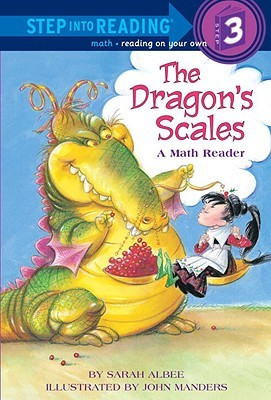 They also helped brainstorm the idea for another book based on an assignment I’d gotten from my editor, and we then read the book that I’d ended up writing.
They also helped brainstorm the idea for another book based on an assignment I’d gotten from my editor, and we then read the book that I’d ended up writing.
The fifth and sixth graders and I talked mostly nonfiction, and they, too, enthusiastically volunteered for the theatrical parts of the presentation (my three doctors ministered to three different patients with plague, yellow fever, and typhus, respectively. And a brave volunteer gamely modeled a ruff collar and a bumroll for the giggling crowd). And for the final talk, to third and fourth graders, we discussed a lot about research and revision, but the fun kind.
It’s sad to put away my bin full of props and costumes for the summer, but I’m looking forward to plunging into the draft for my next two books! Thanks to Mrs. Incillo for organizing this fun day.
The post Last School Visit of the Year! appeared first on Sarah Albee.

